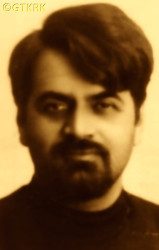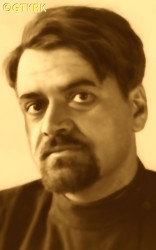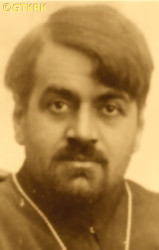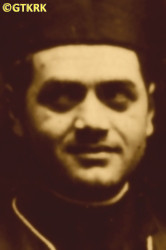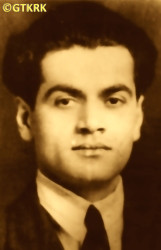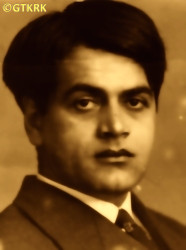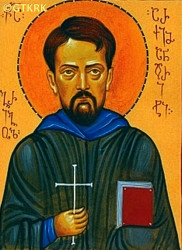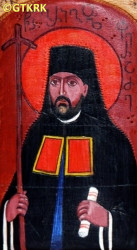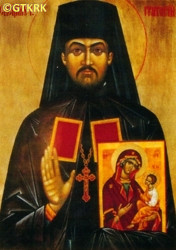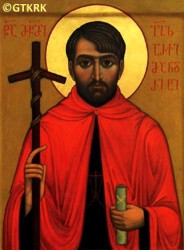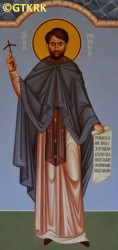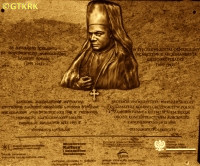Roman Catholic
St Sigismund parish
05-507 Słomczyn
85 Wiślana Str.
Konstancin deanery
Warsaw archdiocese, Poland
full list:
displayClick to display full list

searchClick to search full list by categories
wyświetlKliknij by wyświetlić pełną listę po polsku

szukajKliknij by przeszukać listę wg kategorii po polsku

Martyrology of the clergy — Poland
XX century (1914 – 1989)
personal data
religious status
saint
surname
PERADZE
forename(s)
Gregory (pl. Grzegorz)
forename(s)
versions/aliases
Grigol
religious forename(s)
Gregory (pl. Grzegorz)
canonisation date
19.09.1995

Ilia II Catholicos–Patriarch of All Georgiamore on
en.wikipedia.org
[access: 2022.01.22]
function
religious cleric
creed
Eastern Orthodox Church ORmore on
en.wikipedia.org
[access: 2014.09.21]
diocese / province
Orthodox Patriarchate of Constantinoplemore on
en.wikipedia.org
[access: 2023.07.16]
academic distinctions
Doctor of History
Sacred Orthodox Theology MA
honorary titles
Order of National Hero (Georgia)more on
en.wikipedia.org
[access: 2023.07.16]
(10.2013)
nationality
Georgian
date and place
of death
06.12.1942

KL Auschwitzconcentration camp
today: Oświęcim, Oświęcim gm., Oświęcim pov., Lesser Poland voiv., Poland
more on
en.wikipedia.org
[access: 2022.01.09]
details of death
In 1919 drafted for two year service into Georgian army.
Took part in Georgia defense war against Russians (ending in defeat).
In 1921 for a time in hiding.
After German and Russian invasion of Poland in 09.1939 and start of the World War II, after start of German occupation, did not leave occupied Warsaw (as a foreigner had a chance to leave).
Turned down an offer to lecture at the University of Berlin.
Worked as a translator (the University was closed down by the Germans).
Arrested on 05.05.1942 by the Germans — prob. as a result of a denunciation by pro–German Georgians of spying activities for Great Britain; earlier, in 01.1941, the so‐called Caucasian Committee (Germ. Kaukasische Vetrauenstelle), an organization intended to represent the interests of the Caucasian diaspora towards the German occupier; it is also possible that the reason for the arrest was the activity among the soldiers of the Eastern Legions (Germ. Legionen der Ostvölker), i.e. volunteer, collaborationist armed formations of soldiers from the Caucasus and Central Asia, serving in the German army.
Held in Pawiak prison in Warsaw.
In 10.1941 transferred from the cellar cells to the „working unit” ‐ prob. was used as an interpreter and translator.
In 11.1942 transported to KL Auschwitz concentration camp.
There prob. volunteered to die in place of another inmate: led out together with the prisoners of three other barracks into the freezing cold, where they were to remain until the confession of the person who previously was supposed to steal the bread — then he stepped out of line.
Hounded and murdered after being doused with gasoline and set on fire.
alt. details of death
According to another version, he voluntarily volunteered to die in the gas chamber in place of his fellow prisoner – the father of the family.
cause of death
extermination: exhaustion and starvation
perpetrators
Germans
sites and events
KL AuschwitzClick to display the description, Regierungsbezirk KattowitzClick to display the description, PawiakClick to display the description, GeneralgouvernementClick to display the description, Ribbentrop‐MolotovClick to display the description
date and place
of birth
13.09.1899

Bakurcichetoday: Gurjaani mun., Kakheti reg., Georgia
more on
en.wikipedia.org
[access: 2020.07.31]
parents
PERADZE Roman
🞲 ?, ? — 🕆 1905, ?

SAMADALASZWILI Mary
🞲 ?, ? — 🕆 ?, ?
religious vows
18.04.1931 (permanent)
presbyter (holy orders)
ordination
25.05.1931

Paristoday: Paris dep., Île‐de‐France reg., France
more on
en.wikipedia.org
[access: 2020.11.13]
St Steven OR cathedral churchmore on
en.wikipedia.org
[access: 2025.03.14]
positions held
1933 – 1939
deputy professor — Warsawtoday: Warsaw city pov., Masovia voiv., Poland
more on
en.wikipedia.org
[access: 2021.10.09] ⋄ patrology, Orthodox Theology Department, University of Warsaw [i.e. University of Warsaw (from 1945) / clandestine University (1939‐1945) / Joseph Piłsudski University (1935‐1939) / University of Warsaw (1915‐1935) / Imperial University of Warsaw (1870‐1915)] — lecturer in patrology and history of Georgian monasticism; also: tutor of the departmental Theologians Circle; collaborator of the Oriental Commission of the Warsaw Scientific Society; collaborator of the Polish Library of the Fathers of the Church; participant of scientific trips, e.g. to the Holy Land, Syria, Greece, Bulgaria, Romania, Austria, Italy and Athos (1935); discoverer of Georgian palimpsests from the 6th‐7th centuries (in 1936 in the Holy Land) and the Greek text of the lives of the holy martyrs of Vilnius (on Athos)
05.01.1934
Archimandrite, i.e. superior abbot — Orthodox Patriarchate of Constantinople — dignity conferment
1931 – 1939
parish priest — Paristoday: Paris dep., Île‐de‐France reg., France
more on
en.wikipedia.org
[access: 2020.11.13] ⋄ St Nino OR church — function held also after 1933, after starting work in Warsaw; also: occasional lectures in Paris and Oxford, guest lectures in Dublin and Kraków (1933)
25.05.1931
hieromonk — Paristoday: Paris dep., Île‐de‐France reg., France
more on
en.wikipedia.org
[access: 2020.11.13] ⋄ Orthodox Patriarchate of Constantinople ⋄ St Steven OR cathedral church — priesthood cheirotonia, i.e. ordination
19.04.1931
hierodeacon — Londontoday: London Cou., England, United Kingdom
more on
en.wikipedia.org
[access: 2024.03.19] ⋄ Orthodox Patriarchate of Constantinople ⋄ St Sophie OR cathedral church — diaconate cheirotonia, i.e. ordination, preceded by the adoption of the tonsure and perpetual monastic vows on 18.04.1931
1927 – c. 1931
scientist — Bonntoday: Bonn urban dist., North Rhine‐Westphalia state, Germany
more on
en.wikipedia.org
[access: 2020.10.21] ⋄ history, Frederick William Rhenish University — teacher of Armenian and Georgian languages, and then a private lecturer; also: researcher of Georgian manuscripts in Graz, Austria (c. 1930), co‐founder of the St Nino Georgian parish in the jurisdiction of the Patriarchate of Constantinople in Paris (1929)
1926 – 1927
scientist — Etterbeektoday: Brussels capital mun., Brussels‐Capital reg., Belgium
more on
en.wikipedia.org
[access: 2023.07.16] ⋄ St Michael College, Bollandist Society Research Institute and Library — also: participant of the lectures at the Catholic University of Louvain, researcher of Georgian manuscripts at the British Museum in London and the Bodlean Library in Oxford
1925 – 1926
PhD student — Bonntoday: Bonn urban dist., North Rhine‐Westphalia state, Germany
more on
en.wikipedia.org
[access: 2020.10.21] ⋄ history, Frederick William Rhenish University — PhD thesis „History of Georgian monasticism from its beginning to 1064. A contribution to the history of Eastern monasticism”, public defense in 1926
1922 – 1925
student — Berlintoday: Berlin state, Germany
more on
en.wikipedia.org
[access: 2020.07.31] ⋄ Department of Theology, Friedrich Wilhelm University [i.e. Humboldt University (from 1949) / Friedrich Wilhelm University (1829‐1945) / University of Berlin (1809‐1828)] — postgraduate specialised studies, crowned in 1925with the title of master of sacred Orthodox theology, preceded by a 5‐month German language course
1918 – 1921
student — Tiflistoday: Tbilisi, Georgia
more on
en.wikipedia.org
[access: 2020.11.27] ⋄ philology, State University TSU — also: teacher in the village of Zemo–Tschangaki near Gori (till 1919) and Manavi (c. 1921), with a break for two years of military service
1913 – 1918
student — Tiflistoday: Tbilisi, Georgia
more on
en.wikipedia.org
[access: 2020.11.27] ⋄ philosophy and theology, Orthodox Theological Seminary — initially prob. a minor seminary student at the high school level
polyglot, author of at least 119 published texts, including c. 70 scientific publications, in various languages, including: Germ. „Im Dienste der georgischen Kultur (1926‐1940)” (Eng. „In Service of Georgian culture (1926‐1940)”, 1940; „Apocryphal letter of Dionysius the Areopagite to Timothy, Bishop of Ephesus, about the martyrdom of the apostles Peter and Paul”, Warsaw, 1937; „Biography of Shota Rustaveli”, 1937; „Unknown apocryphal Gospel coming from monophysite circles”, Warsaw, 1935; „Acts of the martyrs”, Warsaw 1934; „Documents concerning the discovery and text of the Codex Sinaiticus”, Warsaw 1934; „The concept, tasks and methods of patrolling in Orthodox theology”, Warsaw, 1934; Germ. „Die altchristliche Literatur in der georgischen Überlieferung” (Eng. „Early Christian Literature in the Georgian Tradition”, Leipzig, 1932
others related
in death
BAZYLUKClick to display biography James (monk Ignatius), HOLCClick to display biography Nicholas, KOROBCZUKClick to display biography Leo, MARTYSZClick to display biography Basil, OHRYZKOClick to display biography Peter, SZWAJKOClick to display biography Paul, ZACHARCZUKClick to display biography Sergius
sites and events
descriptions
KL Auschwitz: German Germ. Konzentrationslager (Eng. concentration camp) KL and Germ. Vernichtungslager (Eng. extermination camp) VL Auschwitz was set up by Germans around 27.01.1940 n. Oświęcim, on the German territory (initially in Germ. Provinz Schlesien — Silesia Province; and from 1941 Germ. Provinz Oberschlesien — Upper Silesia Province). Initially mainly Poles were interned. From 1942 it became the centre for holocaust of European Jews. Part of the KL Auschwitz concentration camps’ complex was Germ. Vernichtungslager (Eng. extermination camp) VL Auschwitz II Birkenau, located not far away from the main camp. There Germans murdered likely in excess of million people, mainly Jews, in gas chambers. In KL Auschwitz alone, the Germans murdered c. 30,000 prisoners by lethal injection. Until 1941, people were killed by intravenous injections of concentrated hydrogen peroxide, ether, hydrogen peroxide, or gasoline. Later, an intracardiac injection was used — with a needle about 10 cm long — of 10‐15 ml of a 30% solution of phenol C6H5OH (acquired from the German concern IG Farben, or more precisely from its subsidiary Bayer, and still used by Bayer AG, among others, for the production of aspirin), which killed within 15 seconds. Altogether In excess of 400 priests and religious went through the KL Auschwitz, c. 40% of which were murdered (mainly Poles). (more on: en.auschwitz.org.plClick to attempt to display webpage
[access: 2012.11.23], www.meczennicy.pelplin.plClick to attempt to display webpage
[access: 2013.07.06])
Regierungsbezirk Kattowitz: After the Polish defeat in the 09.1939 campaign, which was the result of the Ribbentrop‐Molotov Pact and constituted the first stage of World War II, and the beginning of German occupation in part of Poland (in the other, eastern part of Poland, the Russian occupation began), the Germans divided the occupied Polish territory into five main regions (and a few smaller). The largest one was transformed into Germ. Generalgouvernement (Eng. General Governorate), intended exclusively for Poles and Jews and constituting part of the so‐called Germ. Großdeutschland (Eng. Greater Germany). From two separate new provinces were created. The two remaining were incorporated into existing German provinces. One of those was Polish Upper Silesia, which on 08.09.1939, by decree of the German leader Adolf Hitler (formally came into force on 26.10.1939), was incorporated into Germany as the Germ. Regierungsbezirk Kattowitz (Eng. Katowice Regency) and became part of the Germ. Provinz Schlesien (Eng. Province of Silesia) based in Wrocław. On 01.04.1940, the Germ. Regierungsbezirk Kattowitz was enlarged by several pre‐war German counties, and on 18.01.1941, a new German province was created, the Germ. Provinz Oberschlesien (Eng. Province of Upper Silesia), which, apart from the Germ. Regierungsbezirk Kattowitz, also included the Opole region. From 26.10.1939, when the regency was established, the law of the German state was in force there, the same as in Berlin. The main axis of the policy of the new regency, the territory of which the Germans recognized as the Germ. „Ursprünglich Deutsche” (Eng. „natively German”), despite the fact only 6% of its pre–war Polish part were Germans, was Germ. „Entpolonisierung” (Eng. „Depolonisation”), i.e. forced Germanization. The main mechanism was the introduction of the Germ. Deutsche Volksliste DVL, a German nationality list that was supposed to specify the national affiliation of the inhabitants of the region. The largest group marked in the compulsory registrations was Group 3, people who identified themselves as „Silesians” (in 1943 about 41%), and people remaining outside the DVL (about 36%). The latter group was intended to be deported to the Germ. Generalgouvernement (which did not happen en masse because German industry needed slave labor). Group 3, considered by the Germans as capable of Germanization, was subject to certain legal restrictions, and was subject to, among others, to conscription into the German Wehrmacht army. Children could only learn in German. A policy of terror was pursued against the Polish population. There was a special police court, controlled by the Germ. Geheime Staatspolizei (Eng. Secret State Police), i.e. the Gestapo, before which c. 4,000‐5,000 people were detained. For the years 1942‐1945 over 2,000 of them were verified, of which 1,890 were sentenced to death, including 286 in public executions. Thousands of people were murdered during the so‐called «Intelligenzaktion Schlesien», including 300‐650 Polish teachers and c. 61 Polish Catholic priests. The regency hosted a German concentration and extermination camp KL Auschwitz, where the Germans imprisoned c. 1,100,000 Jews (murdering c.1,000,000, i.e. c. 90% of them) and c. 140,000 Poles (murdering c. 70,000, i.e. c. 50% of them). After the end of hostilities of World War II, the overseer of this province, the Germ. Reichsstatthalter (Eng. Reich Governor) and the Germ. Gauleiter (Eng. district head) of the German National Socialist Party, Fritz Brecht, committed suicide. (more on: en.wikipedia.orgClick to attempt to display webpage
[access: 2024.06.24])
Pawiak: Investigative prison in Warsaw, built by the Russian occupiers of Poland in 1830‐1835. During the Poland partition's period, a Russian investigative prison, both criminal and political. During World War II and the German occupation, the largest German prison in the Germ. Generalgouvernement (Eng. General Governorate). Initially, it was subordinate to the Justice Department of the General Governorate, and from 03.1940 Germ. Sicherheitspolizei und des Sicherheitsdienst (Eng. Security Police and Security Service) of the Warsaw District — in particular the German Secret Political Police Gestapo. c. 3,000 prisoners were kept in Pawiak permanently, of which about 2,200 in the men's unit and c. 800 in the women's unit (the so‐called Serbia) — with a „capacity” of c. 1,000 prisoners. In total, in the years 1939‐1944, c. 100,000 Poles passed through the prison, of which c. 37,000 were murdered in executions — from 10.1943 Pawiak prisoners were murdered in open executions on the streets of Warsaw (sometimes several times a day) — during interrogations, in cells or in a prison „hospital”, and c. 60,000 were taken in 95 transports to concentration camps (mainly KL Auischwitz), other places of isolation or to forced labor. The prison Germans demolished during the Warsaw Uprising in 08‐10.1944. (more on: en.wikipedia.orgClick to attempt to display webpage
[access: 2022.08.17])
Generalgouvernement: After the Polish defeat in the 09.1939 campaign, which was the result of the Ribbentrop‐Molotov Pact and constituted the first stage of World War II, and the beginning of German occupation in part of Poland (in the other, eastern part of Poland, the Russian occupation began), the Germans divided the occupied Polish territory into five main regions. In two of them new German provinces were created, two other were incorporated into other provinces. However, the fifth part was treated separately, and in a political sense it was supposed to recreate the German idea from 1915 (during World War I, after the defeat of the Russians in the Battle of Gorlice in 05.1915) of creating a Polish enclave within Germany. Illegal in the sense of international law, i.e. Hague Convention, and public law, managed by the Germans according to separate laws — especially established for the Polish Germ. Untermenschen (Eng. subhumans) — till the Russian offensive in 1945 it constituted part of the Germ. Großdeutschland (Eng. Greater Germany). Till 31.07.1940 formally called Germ. Generalgouvernement für die besetzten polnischen Gebiete (Eng. General Government for the occupied Polish lands) — later simply Germ. Generalgouvernement (Eng. General Governorate), as in the years 1915‐1918. From 07.1941, i.e. after the German attack on 22.06.1941 against the erstwhile ally, the Russians, it also included the Galicia district, i.e. the Polish pre‐war south‐eastern voivodeships. A special criminal law was enacted and applied to Poles and Jews, allowing for the arbitrary administration of the death penalty regardless of the age of the „perpetrator”, and sanctioning the use of collective responsibility. After the end of the military conflict of the World War UU, the government of the Germ. Generalgouvernement was recognized as a criminal organization, and its leader, governor Hans Frank, guilty of war crimes and crimes against humanity and executed. (more on: en.wikipedia.orgClick to attempt to display webpage
[access: 2024.12.13])
Ribbentrop‐Molotov: Genocidal Russian‐German alliance pact between Russian leader Joseph Stalin and German leader Adolf Hitler signed on 23.08.1939 in Moscow by respective foreign ministers, Mr. Vyacheslav Molotov for Russia and Joachim von Ribbentrop for Germany. The pact sanctioned and was the direct cause of joint Russian and German invasion of Poland and the outbreak of the World War II in 09.1939. In a political sense, the pact was an attempt to restore the status quo ante before 1914, with one exception, namely the „commercial” exchange of the so‐called „Kingdom of Poland”, which in 1914 was part of the Russian Empire, fore Eastern Galicia (today's western Ukraine), in 1914 belonging to the Austro‐Hungarian Empire. Galicia, including Lviv, was to be taken over by the Russians, the „Kingdom of Poland” — under the name of the General Governorate — Germany. The resultant „war was one of the greatest calamities and dramas of humanity in history, for two atheistic and anti‐Christian ideologies — national and international socialism — rejected God and His fifth Decalogue commandment: Thou shall not kill!” (Abp Stanislav Gądecki, 01.09.2019). The decisions taken — backed up by the betrayal of the formal allies of Poland, France and Germany, which on 12.09.1939, at a joint conference in Abbeville, decided not to provide aid to attacked Poland and not to take military action against Germany (a clear breach of treaty obligations with Poland) — were on 28.09.1939 slightly altered and made more precise when a treaty on „German‐Russian boundaries and friendship” was agreed by the same murderous signatories. One of its findings was establishment of spheres of influence in Central and Eastern Europe and in consequence IV partition of Poland. In one of its secret annexes agreed, that: „the Signatories will not tolerate on its respective territories any Polish propaganda that affects the territory of the other Side. On their respective territories they will suppress all such propaganda and inform each other of the measures taken to accomplish it”. The agreements resulted in a series of meeting between two genocidal organization representing both sides — German Gestapo and Russian NKVD when coordination of efforts to exterminate Polish intelligentsia and Polish leading classes (in Germany called «Intelligenzaktion», in Russia took the form of Katyń massacres) where discussed. Resulted in deaths of hundreds of thousands of Polish intelligentsia, including thousands of priests presented here, and tens of millions of ordinary people,. The results of this Russian‐German pact lasted till 1989 and are still in evidence even today. (more on: en.wikipedia.orgClick to attempt to display webpage
[access: 2015.09.30])
sources
personal:
pl.wikipedia.orgClick to attempt to display webpage
[access: 2013.02.15]
original images:
www.liturgia.cerkiew.plClick to attempt to display webpage
[access: 2019.05.30], www.liturgia.cerkiew.plClick to attempt to display webpage
[access: 2019.05.30], commons.wikimedia.orgClick to attempt to display webpage
[access: 2019.05.30], www.liturgia.cerkiew.plClick to attempt to display webpage
[access: 2019.05.30], www.liturgia.cerkiew.plClick to attempt to display webpage
[access: 2019.05.30], www.liturgia.cerkiew.plClick to attempt to display webpage
[access: 2019.05.30], www.liturgia.cerkiew.plClick to attempt to display webpage
[access: 2019.05.30], www.liturgia.cerkiew.plClick to attempt to display webpage
[access: 2019.05.30], www.liturgia.cerkiew.plClick to attempt to display webpage
[access: 2019.05.30], www.liturgia.cerkiew.plClick to attempt to display webpage
[access: 2019.05.30], www.liturgia.cerkiew.plClick to attempt to display webpage
[access: 2019.05.30], www.liturgia.cerkiew.plClick to attempt to display webpage
[access: 2019.05.30], www.liturgia.cerkiew.plClick to attempt to display webpage
[access: 2019.05.30], www.liturgia.cerkiew.plClick to attempt to display webpage
[access: 2019.05.30], dzieje.plClick to attempt to display webpage
[access: 2019.05.30], pl.wikipedia.orgClick to attempt to display webpage
[access: 2013.05.19]
LETTER to CUSTODIAN/ADMINISTRATOR
If you have an Email client on your communicator/computer — such as Mozilla Thunderbird, Windows Mail or Microsoft Outlook, described at WikipediaPatrz:
en.wikipedia.org, among others — try the link below, please:
LETTER to CUSTODIAN/ADMINISTRATORClick and try to call your own Email client
If however you do not run such a client or the above link is not active please send an email to the Custodian/Administrator using your account — in your customary email/correspondence engine — at the following address:

giving the following as the subject:
MARTYROLOGY: PERADZE Gregory
To return to the biography press below:
 Click to return to biography
Click to return to biography









